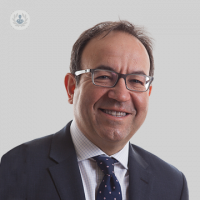Who needs foot surgery for bunions?
Written by:When it comes to a bony lump on the side of your foot, otherwise known as a bunion, pain is the main reason for having surgery. We asked one of our expert orthopaedic surgeons Mr Jordi Sanchez-Ballester all about the benefits of bunion surgery and who would make a suitable candidate for the procedure.

Who can be considered for bunion surgery?
As surgeons, we aim to improve pain, function and mobility of the foot. We advise surgery only for patients that have not responded to simple measures such as pain relief, physiotherapy, podiatry or shoe modifications and the use of splints/spacers between the toes. You may be considered for bunion surgery if you have:
- Severe or constant pain, particularly when walking and standing
- The deformity is so severe that it has an impact on your life
- Recurrent ulceration over the prominence of the bunion
- Difficulty in feeling comfortable when wearing your shoes
It is important to understand that surgery is not recommended for cosmesis only.
What are the surgical options for bunion removal?
There are a number of options for bunion surgery, which will be discussed during your consultation. These options include:
Bunionectomy
This involves removing the bony prominence. This in many occasions is done together with an osteotomy ( breaking and resetting the big toe bones).
The fusion of the big toe joint
The procedure is known as arthrodesis, which removes all movement of the joint. This is a procedure advised for patients where the joint is damaged.
Replacement surgery
This is done in some cases as an alternative option for fusion.
MIS: keyhole surgery
This is an alternative option that might be discussed during the consultation.
Removal of the prominence and re-alignment of the big toe bones/joint is the most common procedure offered.
The operation is commonly performed under regional anaesthesia meaning that just your leg is numbed whilst you remain conscious, but on some occasions, the anaesthetist will advise you to have it under general anaesthesia.
Which benefits would you expect with the surgery?
The outcome of foot surgery is usually good. The main benefits are:
- The majority of patients are relieved of the pain and disability
- Greater independence
- A wider choice of more comfortable shoes
However, it doesn’t mean that all the patients who have the surgery will be completely pain-free. Approximately 1 in 10 patients are not happy with the surgery.
What are the risks of foot surgery?
As with any surgery, there are associated risks and the complications of foot surgery occur in 1 in 20 patients. If you are overweight, smoke or not active, you are at greater risk of developing complications after surgery and it may take longer to recover.
You may want to discuss this with your GP or health professional what you can do before surgery. The main complications are:
- Stiffness or persistent pain in the foot.
- In very few cases, nerves may be damaged, which could lead to chronic pain that may feel worse than the pain before surgery.
- Low risk of a blood clot in the leg or deep vein thrombosis (DVT). All patients should be assessed for DVT risk. If you have no other risk factors, we don’t generally recommend any further treatment. If you develop a DVT, there is a risk that the clot travels to the lung developing a pulmonary embolism.
- A few patients suffer complications such as infections, which are treated by antibiotics and from time-to-time, wounds can become more deeply infected and require further surgery.
- In seldom occasions, further surgery may be required if the deformity recurs or the bones don’t unite in the perfect position.
- Insoles are advised on certain occasions following the corrective surgery. This usually needs a referral to a podiatrist. It’s important to remember that most of the complications are minor and can be easily and successfully treated.
How painful is bunion surgery?
Traditionally, foot surgery was considered quite painful. However, with modern anaesthesia techniques during the procedure, and a combination of painkillers during and after the surgery, patients report very low levels of pain after the surgery and the post-operative recovery. The level of pain that you experience during and after your bunion surgery, however, may depend on your own threshold for pain.
How long is the recovery for bunion surgery?
Usually, the surgery is done as a day case. You won’t be able to drive for between six to eight weeks. If you use an automatic car and the left foot is the foot that is operated on, you may be able to drive after two weeks after the surgery.
You will be given a special shoe that you will wear for approximately six to eight weeks. Normally, you will be able to weight bear during this period of time.
Depending on how steady you are following the surgery, you may need to wear also crutches for the first two to four weeks.
Initial recovery from bunion surgery can be between six to eight weeks long, depending on your own health it may take up to six to eight months to recover fully. You’ll need to take extra care for the first two weeks after your big toe bunion removal and we will give you more tips to recover safely.
If you would like to see Mr Sanchez-Ballester about your bunion, you can book an appointment to see him via his Top Doctor’s profile here.


